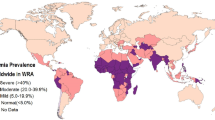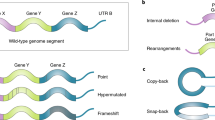Abstract
Trace elements exert a strong influence on immune function. Debilitated humoral and cellular immune responses may impair virus clearance in infected organisms, and favor the generation of virus variants with altered biological properties. The population size in evolving viral quasispecies, as well as increased mutagenesis trigered by oxidative stress, may contribute to altering the outcome of quasispecies evolution in infected hosts. The genetic plasticity of RNA viruses is one of the main obstacles for the control of the diseases they cause and probably a major force in the emergence of new viral pathogens. Recent results suggest links between nutritional deficiencies and the generation of variant viruses, a possibility that is addressed in the present article.
Similar content being viewed by others
References
S. S. Morse,Emerging Viruses, Oxford University Press, Oxford (1993).
S. S. Morse, The viruses of the future? Emerging viruses and evolution, inThe Evolutionary Biology of Viruses, S. S. Morse, ed., Raven, New York, pp 325–335 (1994).
R. G. Webster, W. J. Bean, O. T. Gorman, T. M. Chambers, and Y. Kawaoka, Evolution and ecology of influenza A viruses.Microbiol. Rev 56, 152–179 (1992).
M. Eigen and P. Schuster,The hypercycle—a Principle of Natural Self-Organization. Springer, Berlin, (1979).
E. Domingo, D. L. Sabo, T. Taniguchi and C. Weissmann, Nucleotide sequence heterogeneity of an RNA phage population,Cell 13, 735–744 (1978).
J. J. Holland, J. C. de la Torre and D. A. Steinhauer, RNA virus populations as quasispecies,Curr. Top. Microbiol. Immunol. 176, 1–2 (1992).
E. Domingo, C. Escarmís, N. Sevilla, A. Moya, S. F. Elena, S. F. J. Quer, I. S. Novella and J. J. Holland. Basic concepts in RNA virus evolution,FASEB J. 10, 859–864 (1996).
E. Domingo and J. J. Holland, Mutation rates and rapid evolution of RNA viruses, inThe Evolutionary Biology of Viruses, S. S. Morse, ed., Raven, New York, pp. 161–184 (1994).
R. F. Sellers, Quantitative aspects of the spread of foot-and-mouth disease,Vet. Bull. 41, 431–439 (1971).
C. B. Hall, R. G. Douglas, J. M. Greimann and M. P. Meagher, Viral shedding patterns of children with influenza B infection.J. Infect. Dis. 140, 610–613 (1979).
S. Wain-Hobson, Is antigenic variation of HIV important for AIDS and what might be expected in the future? inThe Evolutionary Biology of Viruses, S. S. Morse, ed., Raven, New York, pp. 185–209 (1994).
A. S. Perelson, A. V. Neumann, M. Markowitz, J. M. Leonard and D. D. Ho, HIV-1 dynamics in vivo: Virion clearance rate, infected cell life-span, and viral generation time,Science,271, 1582–1586 (1996).
E. Domingo, E. Martínez-Salas, F. Sobrino, J. C. de la Torre, A. Portela, J. Ortín, C. López-Galíndez, P. Pérez-Breña, N. Villanueva, R. Nájera, S. VandePol, D. Steinhauer, N. DePolo and J. J. Holland, The quasispecies (extremely heterogeneous) nature of viral RNA genome populations: biological relevance: a review.Gene 40, 1–8 (1985).
E. Domingo and J. J. Holland, Complication of RNA heterogeneity for the engineering of virus vaccines and antiviral agents in:Genetic Engineering, Principles and Methods, vol. 14, J. K. Setlow, ed., Plenum, pp. 13–32 (1992).
I. Nájera, A. Holguín, M. E. Quiñones-Mateu, M. A. Muñoz-Fernández, R. Nájera, C. López-Galíndez, and E. Domingo, Thepol gene quasispecies of human immunodeficiency virus. Mutations associated with drug resistance in virus from patients undergoing no drug therapy.J. Virol 69, 23–31 (1995).
E. Domingo, Biological significance of viral quasispecies. Viral hepatitis Rev.2, 247–261 (1996).
M. Eigen and C. K. Biebricher, Sequence space and quasispecies distribution, inRNA Genetics, vol. 3, E. Domingo, J. J. Holland, and P. Ahlquist, eds., CRC, Boca Raton, FL, pp. 211–245 (1988).
D. A. Steinhauer, J. C. de la Torre, E. Meir and J. J. Holland, Extreme heterogeneity in populations of vesicular stomatitis virus.J. Virol. 63, 2072–2080 (1989).
J. M. C. Gutteridge and B. Halliwell,Antixidants in Nutrition, Health, and Disease, Oxford University Press, Oxford (1994).
J. M. Berg and Y. Shi, The galvanization of biology: a growing appreciation for the roles of zinc.Science 271, 1081–1085 (1996).
J. E. Coleman, Zinc proteins: enzymes, storage proteins, transcription factors, and replication proteins.Annu. Rev. Biochem. 61, 987–946 (1992).
M. J. Coon, A. D. N. Vaz and L. L. Bestervelt, Peroxidative reaction of diversozymes,FASEB J. 10, 428–434 (1996).
R. K. Chandra, Micronutrients and immune functions. An overview, inMicronutrients and Immune functions, vol. 587, A. Bendich and R. K. Chandra, eds., Annals of The New York Academy of Sciences pp. 9–16 (1990).
A. Bendich, Role of antioxidants in the maintenance of immune functions, inNatural Antioxidants, B. Frei, ed., Academic Press, New York, pp. 447–467 (1994).
B. N. Ames, M. K. Shigenaga and T. M. Hagen, Oxidants, antioxidants and the degenerative diseases of aging.Proc. Natl. Acad. Sci. USA 90, 7915–7922 (1993).
E. Peterhans, Oxidants and antioxidants in viral diseases: metabolic regulation and autotoxicity, inNatural Antioxidants B. Frei, ed., Academic, New York, pp. 489–513 (1994).
M. A. Beck, Q. Shi, V. C. Morris and O. A. Levander, Rapid genomic evolution of a non-virulent Coxsackievirus B3 in selenium-deficient mice results in selection of identical virulent isolates.Nature Med. 1, 433–436 (1995).
H. Zumkley, Clinical aspects of selenium metabolism, inSelenium. Present Status and Perspectives in Biology and Medicine G. N. Schrauzer, ed., Humana Press, Clifton, NJ pp. 139–146 (1988).
G. Yang, K. Ge, J. Chen and X. Chen, Selenium-related endemic diseases and the daily selenium requirement of humans.World Rev. Nutr. Diet 55, 98–152 (1988).
M. A. Beck, O. Shi, V. C. Morris and O. A. Levander, From avirulent to virulent: vitamin E deficiency in mice drives rapid evolution of a coxsackie B3 virus.FASEB J. 10, A191 (abstract 1101) (1996).
J. J. Holland, K. Spinder, F. Horodyski, E. Grabau, S. Nichol and S. VandePol, Rapid evolution of RNA genomes.Science 215, 1577–1585 (1982).
Author information
Authors and Affiliations
Corresponding author
Rights and permissions
About this article
Cite this article
Domingo, E. RNA virus evolution, population dynamics, and nutritional status. Biol Trace Elem Res 56, 23–30 (1997). https://doi.org/10.1007/BF02778981
Issue Date:
DOI: https://doi.org/10.1007/BF02778981




